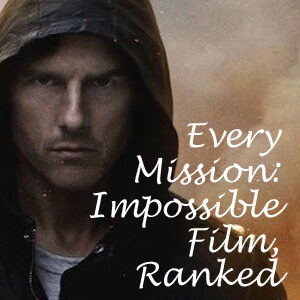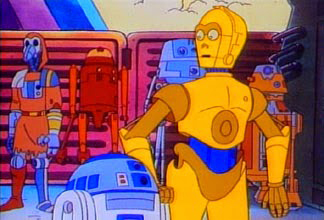There are two categories of old “Star Wars” stuff: That which you consume as entertainment, and that which you consume purely for nostalgia. “Droids,” the 1985-86 animated ABC TV series, falls firmly into the latter category. I loved it when I was 7, but even then my attention span only carried me through the first of the three cycles (“The Trigon One”), which I memorized on repeated Beta viewings.
For some reason, I didn’t catch the second (“Mon Julpa”) or third (“The Adventures of Mungo Baobab”) cycles until the 1990s Sci-Fi Channel reruns – and even then, they didn’t make an impression.
Filling in the gap
I started thinking about “Droids” again after the “Rebels” episode “Droids in Distress,” where we learn that Bail Organa sends R2-D2 and C-3PO on missions to gather information on potential Rebel allies. That made me mentally ret-con the “Droids” adventures into that premise, since the duo tends to leave their master(s) in search of a new one at the end of each cycle without a good a reason.

“Star Wars: Droids” (1985-86)
ABC, 14 episodes
Creator: George Lucas
Writers: Peter Sauder, Ben Burtt, Joe Johnston, Paul Dini, Michael Reaves, Richard Beban, Sharman Divono, Gordon Kent, Steve Wright
Stars: Anthony Daniels, Dan Hennessey, John Stocker
Wouldn’t it be cool if Artoo was secretly gathering info on potential rebels like Thall Joben, Jann Tosh and Mungo Baobab for Bail while Threepio was none the wiser? This would also help “Droids” fit with the canonical idea that the Organa family owns the droids throughout the 20 years between “Episodes III” and “IV.”
Loaded with Lucas elements
Even without an official “Rebels” tie-in, the 14 episodes of “Droids” are loaded with “Star Wars-y” elements that make it clear there was significant involvement from George Lucas and his major collaborators – notably the films’ sound designer, Ben Burtt, and production designer Joe Johnston, both of whom wrote an episode.
For example, the “Trigon One” cycle features a Boonta Eve Podrace.
For better or worse, the series features tons of Eighties elements and cartoon-industry cliches, too. “In Trouble Again,” the electronic-sounding theme song written by Stewart Copeland of The Police, is awesome, and it fits perfectly with the personality of the nervous Threepio.
But the series’ score is rather lazy. There are three main cues – suspense, action and comedy – and while they work perfectly on the “Trigon One” cycle, they wear out their welcome when recycled in future episodes.
‘No blasters, no blasters!’
Despite the fact that many members of the target audience saw the relatively violent “Return of the Jedi” and “Ewok” movies, “Droids” is terrified to show violence – it literally and figuratively pulls its punches, like all Eighties cartoons. There are no blasters in the series; instead, “Star Trek”-style phasers, energy pikes and even seed shooters are used.

Nelvana’s animation – while par for the course by the standards of the time – struggles mightily in any scene involving motion, particularly with spaceships and landspeeders that aren’t traveling in a straight line.
Although it’s always clear what’s going on in a scene, “Droids” is never able to achieve the kinetic thrills of the films or the later animated series.
Here’s a closer look at the three cycles (with cycle titles taken from an article in Star Wars Insider Issue 27, Fall 1995):
CYCLE ONE: “THE TRIGON ONE”
(“The White Witch,” “Escape into Terror,” “The Trigon Unleashed” and “A Race to the Finish”)
I guess I was on to something as a kid, because the arc I was most familiar with is easily the best. Thall Joben, Jord Dusat and Kea Moll have a chemistry similar to Han, Luke and Leia, and I love the way they make the droids feel like they’re part of the family. The similarities are surely no accident, nor is the fact that the planet Ingo looks exactly like Tatooine.
The villains – put-upon Tig Fromm, Tig’s crime-boss dad Sise Fromm, and Tig’s snide henchman Vlix (he of the extremely rare action figure) – are highly entertaining. And there’s just enough of a hint of the evil Empire to scare a young viewer, with the occasional stormtrooper, the fact that Sise Fromm’s mobile chair looks like the Emperor’s throne, and Sise’s mention of having connections to the Emperor.
Jabba the Hutt also gets name-dropped, and Boba Fett goes after our heroes in “A Race to the Finish,” as he owes Sise Fromm a favor.
There’s palpable suspense when cockroach-looking droids zero in on Thall before a commercial break, and when Threepio’s new friend BL-17 turns evil, backed by that soon-to-be-ubiquitous suspense cue.
The scary stuff is balanced out by C-3PO’s slapstick antics, such as his back problems. I don’t remember ever finding droid slapstick to be hilarious, but it doesn’t offend me all that much, either.
With Anthony Daniels providing Threepio’s voice and Artoo’s whistles coming from the Lucasfilm sound library, a tether to the films is always in place. And not just the original trilogy, but also the prequels.
Fourteen years before Lucas put the Boonta Eve Podrace on film in “The Phantom Menace,” he featured a race of the same name in “A Race to the Finish” (although the “podracers” look more like landspeeders here).
Despite officially taking place 15 years before “A New Hope” on the Legends timeline – a time when it seems the Rebellion should not be up and running yet – Kea Moll is described as a rebel, and the gang’s takedown of the crime syndicate’s Trigon One (sort of a mini-Death Star) has rebel undertones.
Still, while the Empire is a background threat throughout “Droids,” the formal Rebel Alliance isn’t introduced.
CYCLE TWO: “MON JULPA”
(“The Lost Prince,” “The New King,” “The Pirates of Tarnoonga,” “The Revenge of Kybo Ren” and “Coby and the Starhunters”)
After the droids inexplicably jump ship and abandon Thall and company, they are purchased by a new master, Jann Tosh, who looks and dresses like Rambo but has a rather tame personality. Also along for the ride is Jessica Meade, who sports Eighties-style hair and “attitude,” but is kinda bland.
The villains of this arc are a huge step down: First, the gang is caught up in a societal feud among the Tammuz-an royalty, similar to many a Marvel “Star Wars” comic. Then clichéd pirate Kybo Ren is the bad guy, although he has gotten a lot of interest lately because his name is similar to “The Force Awakens” villain Kylo Ren.
Finally, in the last episode, a kid’s cat goes missing. Despite being mostly penned by Peter Sauder – who also wrote the “Trigon One” cycle — the plotting on “Droids” drops from standard-but-workable down to sheer laziness.
On the plus side, the “Mon Julpa” cycle is loaded with ties to the wider “Star Wars” mythos, including:
- IG-88, whose voice wildly misses the mark, and his IG-1000, which looks like Darth Maul’s Sith Interceptor;
- the Max Rebo Band playing in a bar;
- the Kenner Desert Sail Skiff and Side Gunner vehicles;
- TIE fighters used by the pirates and an A-wing fighter used by Jann (even though A-wings shouldn’t have existed yet);
- a Desert Sail Skiff, repurposed here for the water planet Tarnoonga;
- Artoo propelling himself underwater, a preview of some the tricked-out gadgetry that would become apparent in the prequels;
- Gamorrean guards;
- a Star Destroyer, albeit of a design different than in the films;
- a mention of the “moon of Bogden,” later used as the location of Jango Fett’s and Count Dooku’s meeting;
- and Fuzzems, which are similar to Yuzzems.
In “The Pirates of Tarnoonga,” Nelvana renders underwater scenes stunningly well considering their general struggles and the fact that even “The Clone Wars” wasn’t brave enough to tackle water until Season 4.
CYCLE THREE: “THE ADVENTURES OF MUNGO BAOBAB”
(“The Great Heep,” “The Tail of the Roon Comet,” “The Roon Games,” “Across the Roon Sea” and “The Frozen Citadel”)
When these episodes first aired in the fall of 1985, the droids were inexplicably in the care of a new master, Mungo Baobab. In the summer of ’86, the hour-long “Great Heep” showed the meeting of Mungo and the droids.
“The Great Heep,” about a giant robot that fuels itself by eating droids, is too long (it only needed to be a half-hour), but it’s notable for breaking from the standard music cues and using a fresh score – the only indication that more money was spent on the primetime special than on the series proper.
Mungo is a merchant, a civilized answer to the smuggler Han Solo. Auren Yomm, of the planet Tawntoom in the Roon System, is a potential love interest.
While chronicled with the same clumsiness as the Anakin-Padme romance, this does mark the only time in “Droids” that male and female characters show more than friendship toward one another. (Years later, the short story “Lando Calrissian: Idiot’s Array” showed us that Mungo and Auren got married.)
While General Koong is your basic corrupt politician and Gaff your standard alien henchman, the overall villainy of this cycle gets a boost with Admiral Screed, who sports a cybernetic eye and speaks in a calm, calculating manner befitting an Imperial.
The Mungo arc is better than the Mon-Julpa arc, but the drawn-out plot of the various parties trying to corner the Roon-stone market gets tiresome.
There are more tie-ins to the wider saga, though: In “The Great Heep,” we see a rolling vehicle similar to what Grievous uses in “Episode III” and a droid spa like the one seen in the “Clone Wars” Season 3 episode “Evil Plans.”
In the “Mungo” cycle proper, we learn the Roon System is located in the Cloak of the Sith (the first on-screen use of the word “Sith”), and we see an X-wing refueling at a water dock, calling to mind the water-skimming X-wings in “The Force Awakens.”
“The Roon Games” emphasizes the spectacle of a racing event even more than “A Race to the Finish,” complete with danger, sabotage and funny alien commentators – not a two-headed announcer, though.
And in an unfortunate parallel to “Star Trek,” creatures that bear a striking resemblance to tribbles provide the (lame attempt at) comic relief in “Tail of the Roon Comet.”
“Droids” will probably never get a proper DVD release, with Disney emphasizing its new canon over Legends canon, although I suppose one could argue the odds are better now than they were under the regime of Lucas, who showed no interest in revisiting this series.
Still, with stories as recent as “Episode III” and “The Clone Wars” drawing from ideas first laid down in “Droids,” it’s likely the series will continue to influence the “Star Wars” saga as it moves forward.
Main photo: ABC publicity photo

